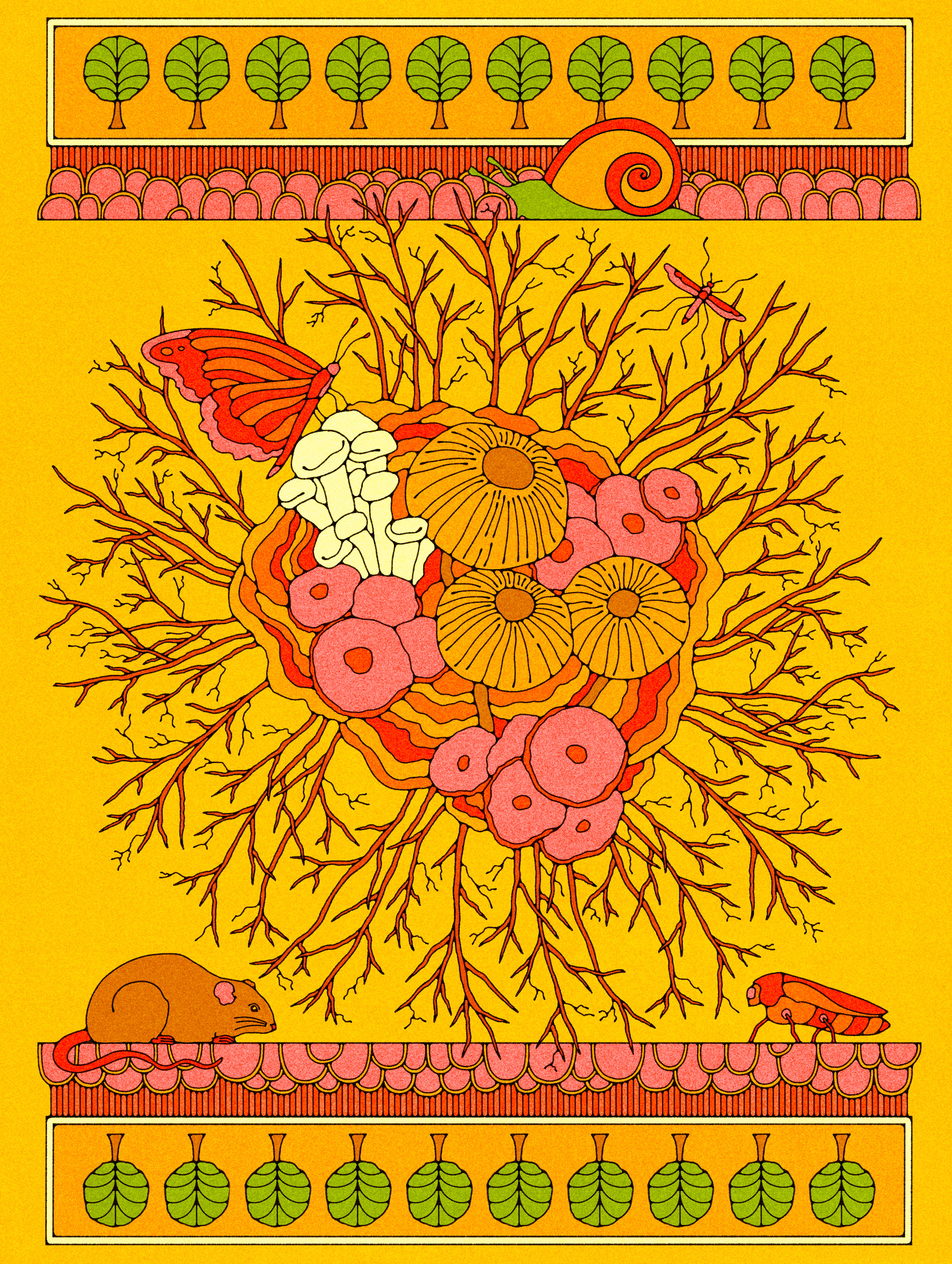How do fungi communicate?
Each fungus may “speak” with many other species— and it turns out they have a lot to say.

Although most of us think of fungi as “mushrooms,” these spore-producing bodies are just the reproductive organs of mycelium—decentralized, weblike bodies of branching tubes. Though usually microscopic, these structures can be enormous; the largest known example is a honey mushroom (Armillaria) that covers almost 10 square kilometers (3.7 square miles) and has lived for millennia.
As organisms living in complex relations to other life forms, fungi could not exist without communicating. And while they’ve traditionally been viewed permanently fixed in place, mycelia move by extending the tips of their tubes through a substrate, which could be a patch of soil or a fallen log.
As fungi grow, they are constantly sensing, learning, and making decisions. Fungi are like polyglots: they both “speak” and understand a wide range of chemical signals. They release and respond to chemicals that float through the air and flow through water. Fascinatingly, fungi not only perceive but actively interpret a chemical’s meaning depending on the context and in relation to other chemicals.
Studies of how fungi communicate lag way behind research on communication of plants and especially of animals. Most are based on several “lab rat” species, so knowledge about other types is limited, but here we summarize what’s known about three realms of communication: within a fungus, between fungi of the same species, and with other organisms.
Within a fungus
Each growing tip has both autonomy from and accountability to the whole organism, akin to the relationship of social insects to the hive. Between the cells within every mycelium flows a stream of chemicals, nutrients, and electrical impulses. Their movements act to keep the whole informed about happenings and coordinate actions across the network. Research by Andrew Adamatzky, a professor of unconventional computing at the University of the West of England in Bristol, suggests that they influence the mycelium’s internal bioelectrical signals, which may form a sort of “language.” While a mycelium neither is nor contains a nervous system, mycelia share much in common with these systems. Both have branched structures, reinforce or prune pathways as needed, and use some of the same amino acids to transmit information.
Between fungi of the same species
Many fungi are sexual and must mate to reproduce. They send out pheromones and “sniff” out those of others, and then they grow toward those that seem attractive (based on whatever it is fungi are attracted to). Whenever two mycelia meet, they communicate to negotiate their relationship, which can range from fusion (to form a reproductive or nonreproductive partnership) to indifference to physical exclusion and even chemical antagonism. Each mated mycelium negotiates the physical dynamics of fusion, and of life in partnership thereafter.
With other organisms
Fungi "talk" and respond to many other beings. Through mycorrhizal mutualisms, they may share water and food with plant partners. Parasitic fungi produce a myriad of plant growth regulators, modifying plants to suit their needs. Some fungi, such as truffles, mimic animal sex pheromones to attract mammals and insects that act as “sporinators,” the fungal equivalent to pollinators. Other fungi are prey to roundworms (also known as nematodes). When they detect a nematode nearby, they can produce defensive compounds to ward it off. Other fungi hunt nematodes by detecting their chemical presence.
Mycorrhizal fungi are central in current debates about the “wood-wide web,” but many representations unfairly present fungi as living fiber-optic cables that allow trees to “talk” to each other. Fungi are more than just passive wires; they are, in fact, actively perceiving, interpreting, and signaling themselves. They do this constantly, with a wide range of beings. How mushrooms create and interpret these signals in a cacophony of chemical and electrical noise remains a fascinating mystery.
Michael Hathaway is the author of What a Mushroom Lives For: Matsutake and the Worlds They Make. Willoughby Arévalo is the author of DIY Mushroom Cultivation: Growing Mushrooms at Home for Food, Medicine, and Soil.
Deep Dive
Biotechnology and health
How scientists traced a mysterious covid case back to six toilets
When wastewater surveillance turns into a hunt for a single infected individual, the ethics get tricky.
An AI-driven “factory of drugs” claims to have hit a big milestone
Insilico is part of a wave of companies betting on AI as the "next amazing revolution" in biology
The quest to legitimize longevity medicine
Longevity clinics offer a mix of services that largely cater to the wealthy. Now there’s a push to establish their work as a credible medical field.
There is a new most expensive drug in the world. Price tag: $4.25 million
But will the latest gene therapy suffer the curse of the costliest drug?
Stay connected
Get the latest updates from
MIT Technology Review
Discover special offers, top stories, upcoming events, and more.